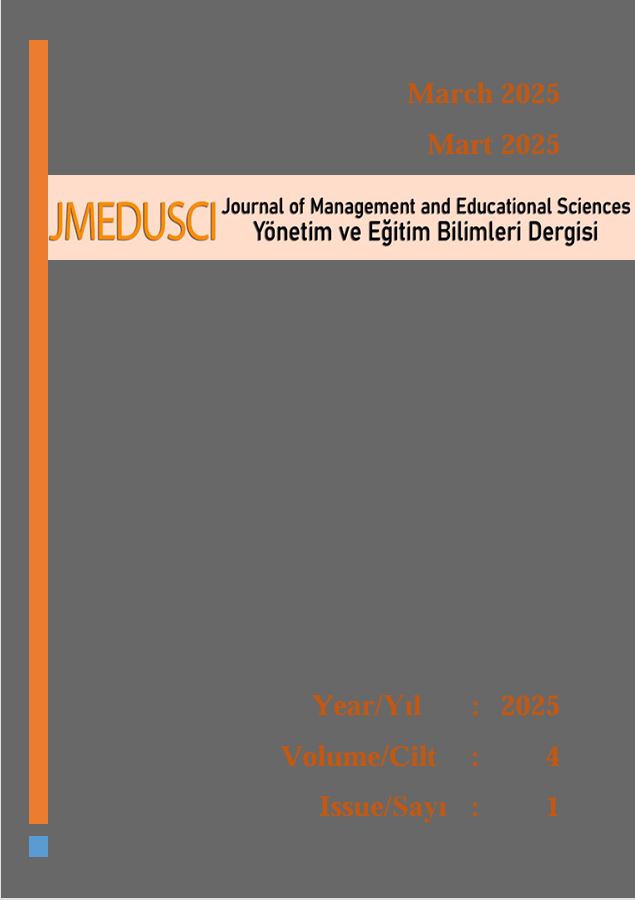Examining the Relationship Between Teacher Autonomy Behaviors and Classroom Management Styles
Öğretmen Özerklik Davranışları ile Sınıf Yönetim Stilleri Arasındaki İlişkinin İncelenmesi
Keywords:
Teacher, teacher autonomy, classroom management stylesAbstract
The aim of this research is to examine the relationship between teacher autonomy and classroom management styles according to teachers' opinions. Relational screening model was used in the research. In the first finding of the research; classroom management styles and teacher autonomy levels are above average. As a result of the analysis; men's perceptions of classroom management styles were found to be higher than women. On the other hand, it was revealed that teacher autonomy perceptions did not change according to women and men. In the examination made according to age groups; it was found that the difference between teacher autonomy and the arithmetic means of age groups was statistically significant. Accordingly, it was concluded that the perception of teacher autonomy of the 31-40 age group was higher than the 41-50 age groups. The difference between the arithmetic means of classroom management styles and age groups was found to be statistically significant. Accordingly, it was concluded that the perception of classroom management styles of the 31-40 and 41-50 age groups was higher than the 20-30 age groups. On the other hand, it was revealed that teachers' perceptions of teacher autonomy and classroom management styles did not change according to being married or single. In the examination made according to educational status; It was found that the perception of autonomy of teachers with a master's degree was higher than that of teachers with a bachelor's degree. On the other hand, it was found that there was no difference in their perceptions of classroom management styles according to their educational background. In the examination made according to professional experience; the difference between the arithmetic means of teacher autonomy and professional experience groups was not found to be statistically significant. However, the difference between the arithmetic means of classroom management styles and professional experience groups was found to be statistically significant. Accordingly, it was concluded that the perception of classroom management styles of the group between the ages of 17-24 was higher than the groups between the ages of 1-8 years. On the other hand, the difference between the arithmetic means of the institution type groups where the perceptions of teacher autonomy and classroom management styles were applied was not found to be statistically significant. Finally, within the scope of the research, a significant, low-level and positive relationship was found between the general dimensions of teacher autonomy and classroom management styles, while teachers' perceptions of autonomy significantly predicted their perceptions of classroom management styles. In other words, a 100-unit increase in the dimension of teachers' autonomy increased their perceptions of classroom management styles by 23.7%.
References
Aktan, S., & Sezer, F. (2018). Sınıf yönetimi stilleri ölçeği’nin psikometrik özelliklerinin incelenmesi. Kastamonu Education Journal, 439-449.
Aoki, N. (2002). In Learner Autonomy 7: Challenges to Research and Practice. Teacher Autonomy: Capacity, Freedom and Responsibility., 111-124.
Ayral, M. (2014). Öğretmen özerkliği ile öğrenci başarısı arasındaki ilişki: PISA örneği. Eğitim Bilimleri Araştırma Dergis, 207-218.
Berger, J., Girardet, C., Vaudroz, C., & Crahay, M. (2018). Teaching experience, teachers’ beliefs, and self-reported classroom management practices: a coherent network. Sage Open, 8(1). https://doi.org/10.1177/2158244017754119
Brandišauskienė, A., Bukšnytė-Marmienė, L., Daugirdienė, A., Česnavičienė, J., Jarašiūnaitė, G., Kemerytė-Ivanauskienė, E., … & Nedzinskaitė, R. (2022). Teachers’ autonomy-supportive behaviour and learning strategies applied by students: the role of students’ growth mindset and classroom management in low-ses-context schools. Sustainability, 14(13), 7664. https://doi.org/10.3390/su14137664
Çolak, İ., & Altınkurt, Y. (2017). Okul iklimi ile öğretmenlerin özerklik davranışları arasındaki ilişki. Kuram ve Uygulamada Eğitim Yönetimi, 33-71.
Kadel, P. (2021). Challenges of teacher autonomy for professional competence. Interdisciplinary Research in Education, 5(1-2), 39-46. https://doi.org/10.3126/ire.v5i1-2.34733
Koçak, A. (2018). He Effects Of Teacher Autonomy Perceptıons Of Englısh As A Foreıgn Language Teachers On Theır Burnout Levels: Van Case. Konya: Necmettin Erbakan Unıversıty.
Main, S. and Hammond, L. (2008). Best practice or most practiced? pre-service teachers’ beliefs about effective behaviour management strategies and reported self-efficacy. Australian Journal of Teacher Education, 33(4). https://doi.org/10.14221/ajte.2008v33n4.3
Nguyen, H. (2019). Autonomous, but together: exploring elementary school teachers' sense of autonomy and self-efficacy. Journal of Educational Methodology. https://doi.org/10.3102/1429473
Öztürk, İ. H. (2011). Öğretmen özerkliği üzerine kuramsal bir inceleme. Elektronik Sosyal Bilimler Dergisi, 82-99.
Şimşek, H., & Yıldırım, A. (2013). Sosyal Bilimlerde Nitel Araştırma Yöntemleri. Ankara: Seçkin Yayınevi.
Tabachnick, B., & Fidell, L. (2013). Using Multivariate Statistics. Boston : Pearson.
Webb, P. T. (2002). Teacher Power: The Exercise of Professional Autonomy in an Era of Strict Accountability. Teacher Development, 47-62.
Yolcu, O. and Akar-Vural, R. (2021). An examination of instructional autonomy practices of science teachers. International Journal of Educational Methodology, 7(1), 79-94. https://doi.org/10.12973/ijem.7.1.79
Downloads
Published
How to Cite
Issue
Section
License
Copyright (c) 2025 Journal of Management and Educational Sciences

This work is licensed under a Creative Commons Attribution 4.0 International License.


